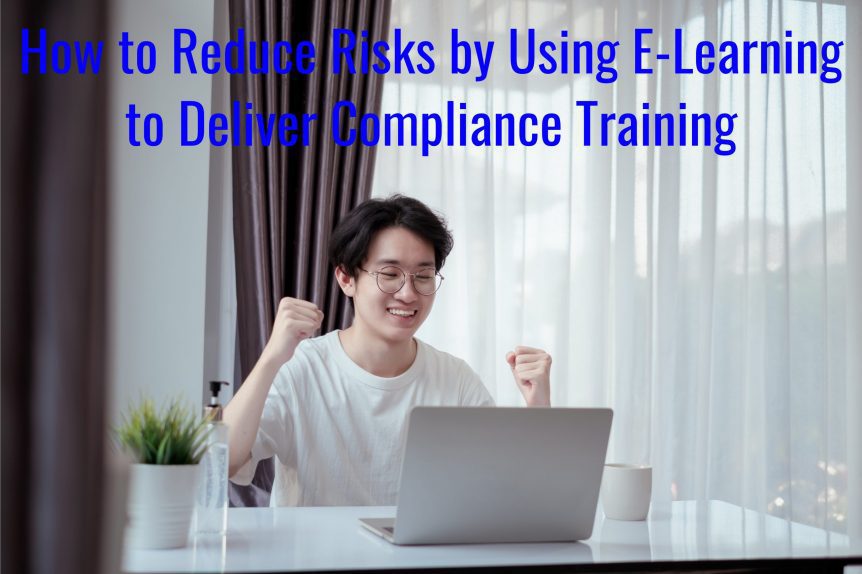How to Reduce Risks by Using E-Learning to Deliver Compliance Training
Whatever industry you are in, compliance training can be a challenging issue. It is too often considered a slog that everyone tries to get through as cleanly as possible, usually by memorising as much of the content as they can so they can pass the quiz at the end of the course.
The problem is that most compliance training is about reducing risks. Passing a one-off quiz won’t reduce risks, however. To reduce risks, you need behavioural change. That means your training needs to engage learners with scenarios and conditions they can relate to. It’s also important to expose them to potential real-life situations within the safety of a training environment. This is where e-learning comes in.
Using E-Learning to Improve Compliance Training and Reduce Risks
E-learning is a powerful tool for delivering compliance training as it can move it beyond an exercise in remembering to a learning experience that changes behaviours and delivers tangible results. Those results can include reducing risks in your business.
You can’t just turn to e-learning and hope for the best, though. The following tips and ideas will help make your e-learning compliance training as effective as possible with a focus on reducing risks.
Personalised Training Content
Learners can become disconnected from compliance training when they feel it doesn’t apply to them or if they can’t relate to the topic. You can overcome both these issues by making the training a personalised as possible.
With other forms of training delivery, personalising content is not always easy. It is a more straightforward process with e-learning, however. Depending on the level of technical detail you go to, you can personalise content between groups of people – roles, departments, or business units, for example – or you can go right down to the individual level.
By personalising the content, you will keep learners engaged, which will have a positive impact on outcomes, specifically behavioural change.
Branching Scenarios
Learning by remembering is nowhere near as effective as learning by doing. That’s why learning on the job is such a popular option for many people and in many situations. Learning on the job is not really possible with compliance training, however, as any mistakes or delays can cause your company regulatory or legal issues.
E-learning provides the solution through branching scenarios. Branching scenarios are a learning tool that teaches by doing.
With a branching scenario, you present learners with a situation and ask them to make a decision. That decision alters the situation and presents the learner with another decision to make. In other words, branching scenarios show learners how their decisions impact both how situations play out as well as the end result.
Simulations
Simulations are another e-learning tool that can enhance your e-learning compliance courses. Rather than being decision-based like branching scenarios, they ask users to take action – control a machine, operate a piece of equipment, etc.
So, simulations also teach by doing, making them highly effective for compliance topics.
They offer another benefit too – safety. E-learning simulations make it possible for you to put learners in virtual situations that would be highly dangerous in real life. An example would be a situation where the learner is dealing with a toxic substance. As the simulation is just that (i.e., a virtual representation of a real-world risk), the learner is no danger.
Video Demonstrations
While video demonstrations are not as interactive as the previous two options on this list, they are still a very effective tool you can use to improve the quality of your compliance training and increase engagement. In many situations, video demonstrations are much more effective than explaining a concept using text or images.
Real-World Stories
Real-world stories are another tool you can use in your e-learning content, especially in situations where learners have no direct knowledge or experience of compliance situations that have gone wrong. Without this direct knowledge or experience, there is always the risk that learners won’t fully grasp the gravity of the topic.
Plus, with e-learning, you can make stories come to life with images, animated videos, infographics, and more.
Keep Your Content Up to Date
Keeping content up to date is essential for compliance topics. It is essential for compliance reasons as you don’t want to give your team outdated information. It is also essential for learner engagement as those completing your course may take it less seriously if they think the content is outdated.
With some methods commonly used to conduct compliance training, keeping content up to date can be challenging. It is much easier with e-learning, however, as you simply update the relevant module with the new information, and it can be instantly available across the UAE and/or Saudi Arabia to everyone that needs it.
Engagement is the Key to Success in Compliance Training
To reduce risks related to compliance issues, one of the things you need is effective training. Training isn’t the only thing you need, of course, as good management, robust procedures, top-level buy-in, and good oversight are also important. However, training does play an essential role.
Most people involved in compliance training will tell you that one of the most important elements is engagement – if you can get those completing your training to engage with the content, you will have much greater success.
E-learning is one of the most engaging learning delivery methods available, making it ideal for compliance training. With the right e-learning developer, you can create compliance training for your business that is engaging, and that helps to reduce risks.
